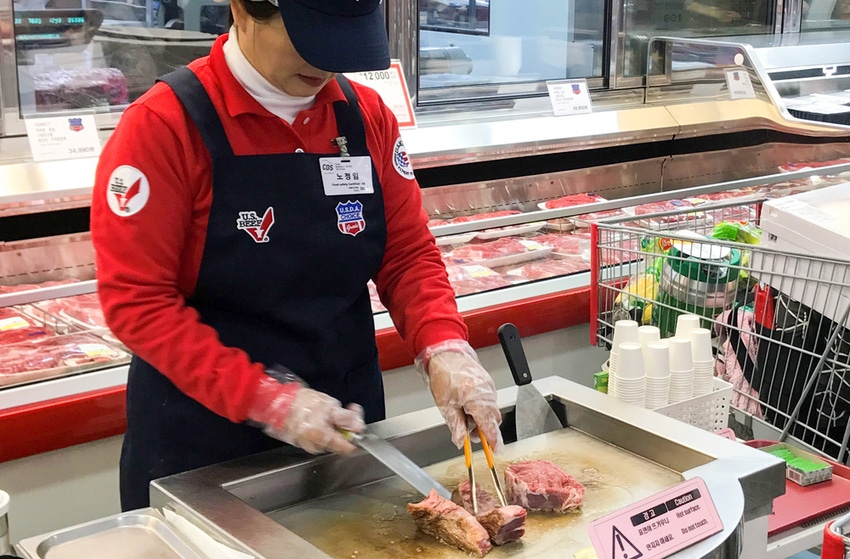Without KORUS, U.S. beef would still be saddled with a 40% tariff while our competitors capitalized on reduced duty rates.
September 7, 2017

The Office of the U.S. Trade Representative (USTR) recently called for a special session of the Korea-U.S. Free Trade Agreement (KORUS) Joint Committee to discuss possible modifications to the agreement. Following the Aug. 22 meeting, U.S. Trade Representative Robert Lighthizer noted that he specifically hopes to address expansion of the United States’ trade deficit with South Korea since KORUS was implemented in 2012. Over the Labor Day weekend, reports surfaced that the Trump administration was considering withdrawal from KORUS. It now appears the administration will continue to pursue changes to the agreement, but has no immediate plans to withdraw. Thad Lively, U.S. Meat Export Federation (USMEF) senior vice president for trade access, notes this is very positive news for the U.S. beef industry.
“The Trump administration’s focus on the balance of trade with key trading partners like Korea raises some important questions about changes that are occurring in the global economy, but the fact remains that KORUS has been beneficial to the U.S. beef industry and the industry is making a very positive contribution to the balance of trade with Korea,” Lively explained. USMEF, along with the National Cattlemen’s Beef Association and the North American Meat Institute, recently highlighted the importance of the Korean market in a letter to Lighthizer and U.S. Agriculture Secretary Sonny Perdue.
“Even though the administration’s concerns about the trade balance with Korea are mainly focused on the manufacturing sector, when a trade agreement is opened up for renegotiation, all aspects of that agreement are back on the table.” Lively adds. “This is why it is so important to bring the administration’s attention to the benefits that KORUS has delivered for the U.S. beef industry.”
Last year, U.S. beef exports to Korea exceeded $1 billion for the first time, making it the second-largest value destination for U.S. beef behind Japan. This strong momentum has continued in 2017, as exports through June were up 13% year-over-year in volume to 83,357 metric tons (mt), valued at $527.7 million (up 21 percent). The U.S. also captured more than 50% of Korea’s chilled beef market for the first time in the post-BSE era, as exports of chilled U.S. beef totaled 18,816 mt, up 83% year-over-year, valued at $166 million, up 86%.
KORUS has played a critical role in U.S. beef’s success in Korea, not only by ensuring U.S. beef is on a level playing field with its main competitors, but also by fostering growth in Korea’s beef consumption by making U.S. beef more affordable to Korean consumers. Prior to 2012, all imported beef entering Korea was subject to a 40% duty – one of the highest rates in the world.
Under KORUS, the duty rate on U.S. beef is phased to zero over 15 years, and it currently stands at 24%. The importance of this duty rate reduction is underscored by the fact that shortly after KORUS was implemented, Korea also entered free trade agreements with Australia, Canada and New Zealand. Without KORUS, U.S. beef would still be saddled with a 40% tariff while beef imports from our competitors capitalized on reduced duty rates, currently 29% for Australia and 32% for Canada and New Zealand.
Lower duties definitely benefit Korean consumers, and they have responded in a big way. At a time when Korea’s domestic beef prices are very high, per capita consumption is soaring – increasing more than 25% since 2010 to about 11.5 kilograms. In fact, South Koreans consume more U.S. beef per person (just over 3 kilograms) than consumers in any other export market.
On a per-head basis, the impact of U.S. beef’s success in Korea is striking. In 2017, U.S. beef export value has equated to about $270 for every fed steer and heifer slaughtered. Exports to Korea account for about 16% or $43 of this total. This is second only to Japan, which accounts for 27% ($72). Breaking this down further, exports of short ribs and chuck short ribs to Korea average $18 per head slaughtered.
“These are significant dividends for U.S. farmers and ranchers, especially as the industry looks to the export markets to take a larger share of our increasing beef production and play a greater role in supporting industry profitability,” Lively says. “Following the BSE-related closure of the Korean market to U.S. beef, the U.S. industry faced a long and very difficult recovery in terms of restoring consumer confidence and winning back market share.
“Without KORUS, a recovery of this magnitude would not have been possible. USMEF, together with our beef industry partners, will continue to remind U.S. trade officials of the critical role that KORUS and other trade agreements play in the beef industry’s export-focused strategy for the future.”
Joe Schuele is vice president, communications, with the U.S. Meat Export Federation in Denver, Colo.
About the Author(s)
You May Also Like



